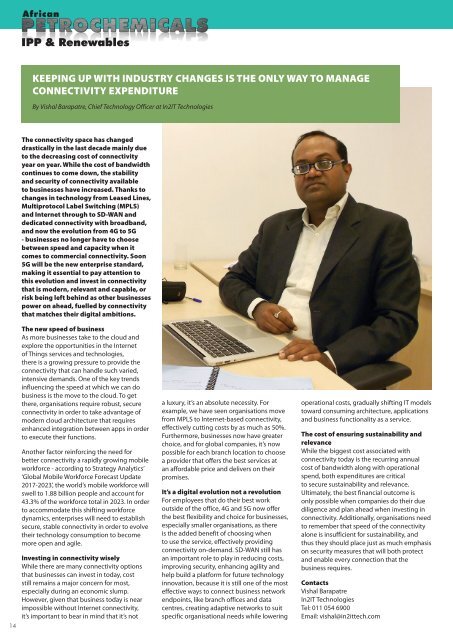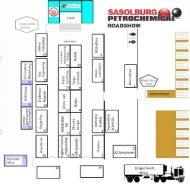African Petrochemicals Edition 16.3
Create successful ePaper yourself
Turn your PDF publications into a flip-book with our unique Google optimized e-Paper software.
IPP & Renewables<br />
KEEPING UP WITH INDUSTRY CHANGES IS THE ONLY WAY TO MANAGE<br />
CONNECTIVITY EXPENDITURE<br />
By Vishal Barapatre, Chief Technology Officer at In2IT Technologies<br />
The connectivity space has changed<br />
drastically in the last decade mainly due<br />
to the decreasing cost of connectivity<br />
year on year. While the cost of bandwidth<br />
continues to come down, the stability<br />
and security of connectivity available<br />
to businesses have increased. Thanks to<br />
changes in technology from Leased Lines,<br />
Multiprotocol Label Switching (MPLS)<br />
and Internet through to SD-WAN and<br />
dedicated connectivity with broadband,<br />
and now the evolution from 4G to 5G<br />
- businesses no longer have to choose<br />
between speed and capacity when it<br />
comes to commercial connectivity. Soon<br />
5G will be the new enterprise standard,<br />
making it essential to pay attention to<br />
this evolution and invest in connectivity<br />
that is modern, relevant and capable, or<br />
risk being left behind as other businesses<br />
power on ahead, fuelled by connectivity<br />
that matches their digital ambitions.<br />
14<br />
The new speed of business<br />
As more businesses take to the cloud and<br />
explore the opportunities in the Internet<br />
of Things services and technologies,<br />
there is a growing pressure to provide the<br />
connectivity that can handle such varied,<br />
intensive demands. One of the key trends<br />
influencing the speed at which we can do<br />
business is the move to the cloud. To get<br />
there, organisations require robust, secure<br />
connectivity in order to take advantage of<br />
modern cloud architecture that requires<br />
enhanced integration between apps in order<br />
to execute their functions.<br />
Another factor reinforcing the need for<br />
better connectivity a rapidly growing mobile<br />
workforce - according to Strategy Analytics’<br />
‘Global Mobile Workforce Forecast Update<br />
2017-2023’, the world’s mobile workforce will<br />
swell to 1.88 billion people and account for<br />
43.3% of the workforce total in 2023. In order<br />
to accommodate this shifting workforce<br />
dynamics, enterprises will need to establish<br />
secure, stable connectivity in order to evolve<br />
their technology consumption to become<br />
more open and agile.<br />
Investing in connectivity wisely<br />
While there are many connectivity options<br />
that businesses can invest in today, cost<br />
still remains a major concern for most,<br />
especially during an economic slump.<br />
However, given that business today is near<br />
impossible without Internet connectivity,<br />
it’s important to bear in mind that it’s not<br />
a luxury, it’s an absolute necessity. For<br />
example, we have seen organisations move<br />
from MPLS to Internet-based connectivity,<br />
effectively cutting costs by as much as 50%.<br />
Furthermore, businesses now have greater<br />
choice, and for global companies, it’s now<br />
possible for each branch location to choose<br />
a provider that offers the best services at<br />
an affordable price and delivers on their<br />
promises.<br />
It’s a digital evolution not a revolution<br />
For employees that do their best work<br />
outside of the office, 4G and 5G now offer<br />
the best flexibility and choice for businesses,<br />
especially smaller organisations, as there<br />
is the added benefit of choosing when<br />
to use the service, effectively providing<br />
connectivity on-demand. SD-WAN still has<br />
an important role to play in reducing costs,<br />
improving security, enhancing agility and<br />
help build a platform for future technology<br />
innovation, because it is still one of the most<br />
effective ways to connect business network<br />
endpoints, like branch offices and data<br />
centres, creating adaptive networks to suit<br />
specific organisational needs while lowering<br />
operational costs, gradually shifting IT models<br />
toward consuming architecture, applications<br />
and business functionality as a service.<br />
The cost of ensuring sustainability and<br />
relevance<br />
While the biggest cost associated with<br />
connectivity today is the recurring annual<br />
cost of bandwidth along with operational<br />
spend, both expenditures are critical<br />
to secure sustainability and relevance.<br />
Ultimately, the best financial outcome is<br />
only possible when companies do their due<br />
diligence and plan ahead when investing in<br />
connectivity. Additionally, organisations need<br />
to remember that speed of the connectivity<br />
alone is insufficient for sustainability, and<br />
thus they should place just as much emphasis<br />
on security measures that will both protect<br />
and enable every connection that the<br />
business requires.<br />
Contacts<br />
Vishal Barapatre<br />
In2IT Technologies<br />
Tel: 011 054 6900<br />
Email: vishal@in2ittech.com

















